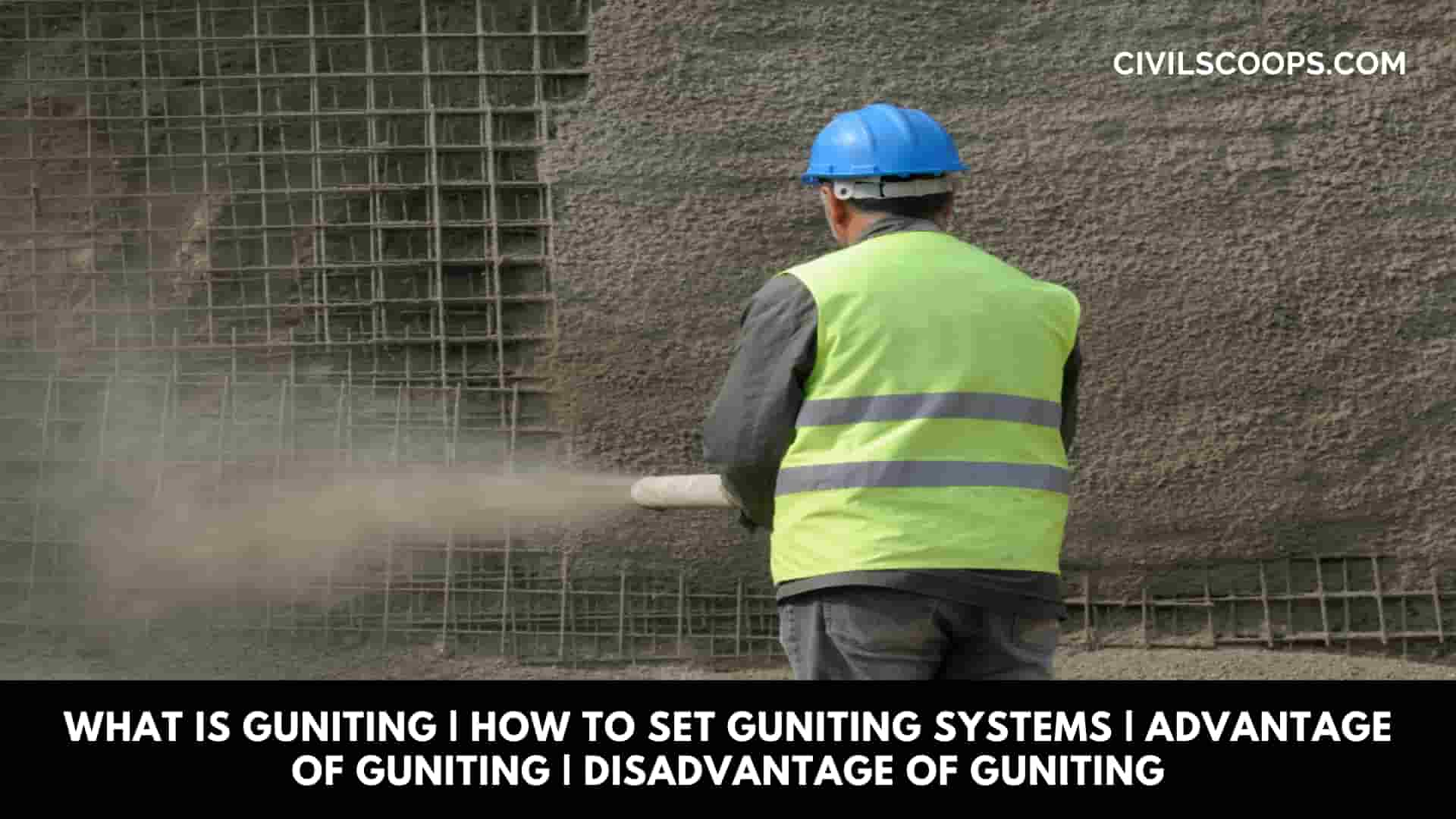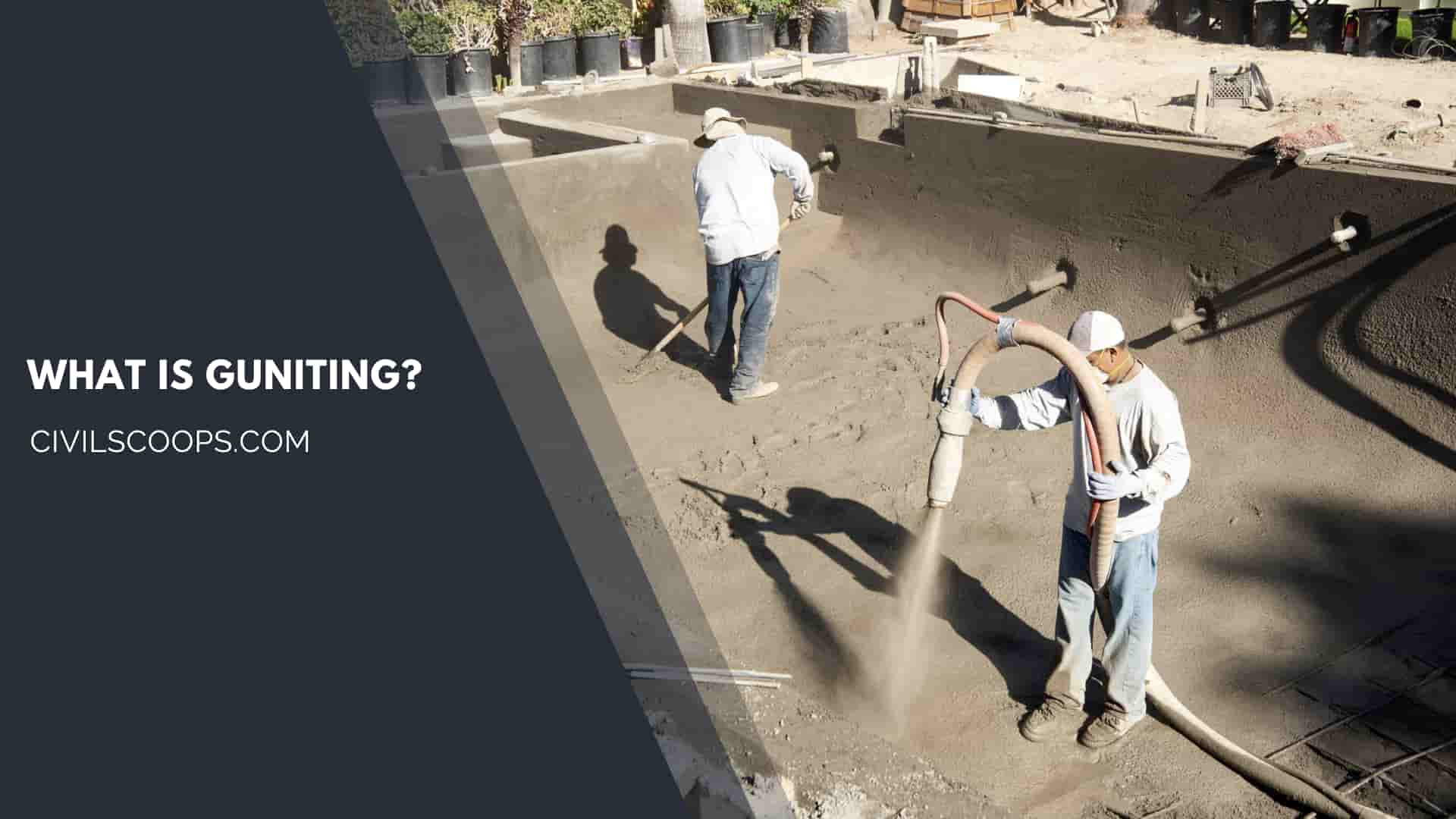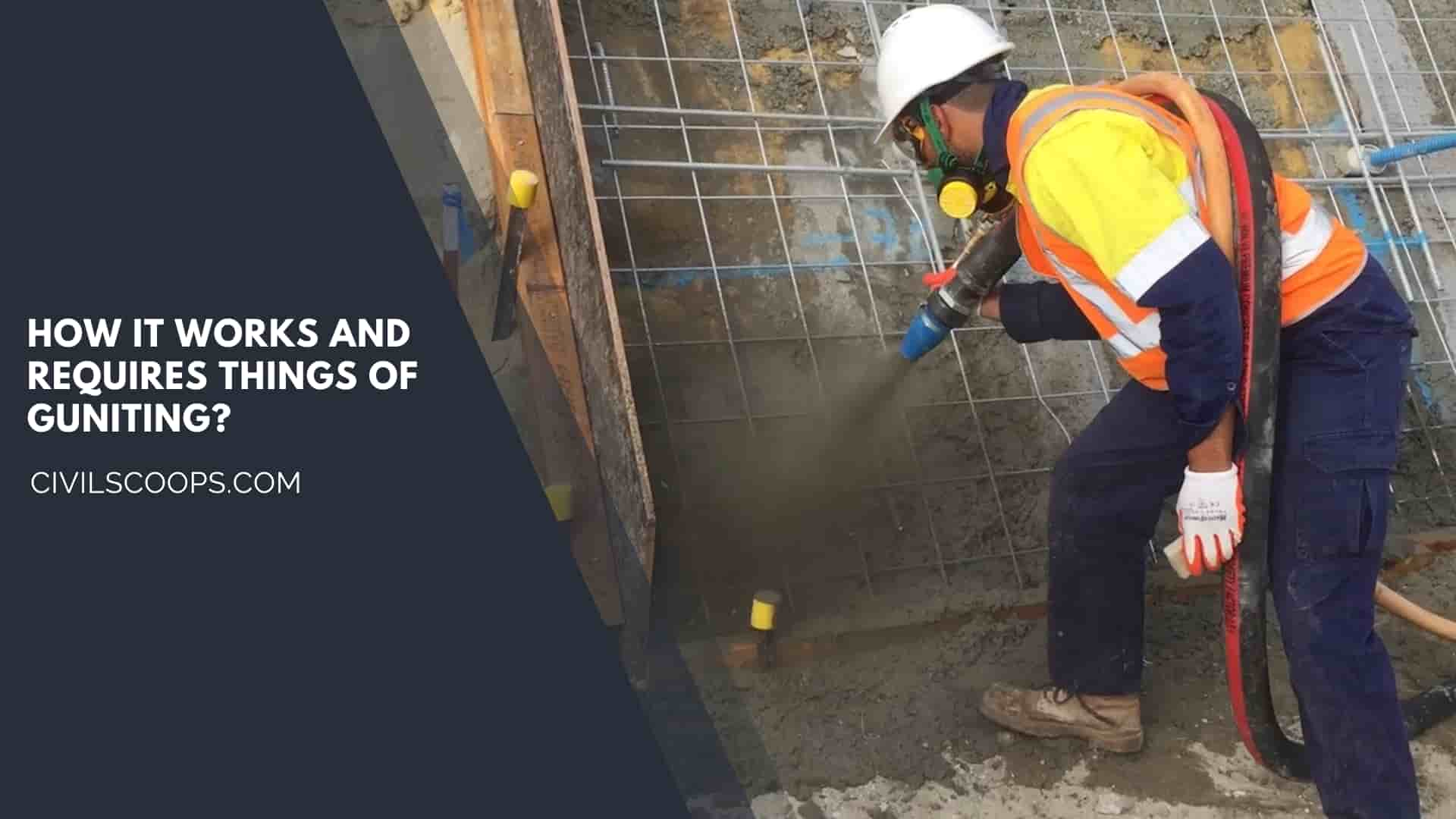What Is Guniting | How to Set Guniting Systems | Advantage of Guniting | Disadvantage of Guniting

Table of Contents
What Is Guniting?

The process was applicable in construction work, where it applied in the stabilization of prone or sloppy areas.
Mainly purpose of this process is to heal some specific kinds of problems, like tank construction (contain water, storage for some specific chemicals), swimming pool construction, retaining wall for basement tanks, and repair works for all those.
Many other examples where it used are Slope stabilization, Dome Construction, Tunneling, Retention walls, Water tanks and pools, Artificial ponds, Ditches, and Channels, As structural reinforcement, Mining applications Dikes and dams
The US was the place where this process was generated first. Mostly in this process, by using a spray gun mixture of concrete or mortar applied on the surface.
The name of this method called by the mechanism of the spray gun and famous as Guniting. Afterward, technology got improve with time, and mechanism changes with its capacity, nozzle replaces the pipe.
Furthermore, the velocity of spray jet increased by using compressed pressure with intense high speed, all these developments done by the American Railway Engineers Association (in year1930), also known as AREA.
In the year 1950, The American Institute of concrete also accept this process; however, they introduce it as “shotcrete.” It was in the form of a wet or dry mix.
During those periods of time, they never use word guniting for it. Lately, the guniting name given to the process of dry How to set Guniting systems shotcreting, thus it slightly differs from guniting (like subpart).
Hardly few nations familiar with this word; on the other hand, shotcrete makes imprints among those nations.
How to Set Guniting Systems?

The mixture made by dry content mixed in a place known as bin and cement gun stored mixture. When the mixture is ready to apply on the surface, under the control pressure and intense high velocity, mixture hit the surface after water addition in it and passed through a nozzle.
Afterward, it’s released to hit on the surface. The pressure generated in water flow by using the water tank, which releases water at adequate pressure to the nozzle, thus this high-pressure flow throw mixture.
Cautions to Set High Quality in the Process of Guniting :
- Firstly, before applying it on the surfaces or areas of application, we have to clear it by using the sandblasting method; mostly, it used to remove the steel surface, which affected by the rust due to various reasons.
- There are many kinds of mixer proportions used to make guniting, mostly 1:3 and 1:4:5 percentages acceptable for it. A strength of this mixture is nearly 70MP when it measured on the 7th day of applications. Moreover, 0.30 is its WC(water-cement) ratio.
- The quality of work through this process also depends on the many factors, however, mainly skillful operators and controllers of the nozzle.
- In some cases, make sure that this guniting process is applicable after 6 hours of surface treatment.
- Mostly surface cleaning processes are done by using a high-pressure water jet or by adopting the air blast method according to circumstances.
- Some materials like grease, mud, dirt, or any other materials.
- One condition that must be followed during the making of the mixture is the size of the aggregate should be less than 10mm.
- To increase life validity, make sure that mortar quality must be high or according to its set criteria of manufacturing.
How It Works and Requires Things of Guniting?

It works on a mechanism system, which includes a jet pipe or nozzle used to throw the material on the surface at high velocity and compressed pressure.
This mixer made by adding water according to the requirement of concrete mix, a combination of this dry material and water ready to apply on the surface.
The water used to make that combination is on an accurate level, and it also controls by manually. Mostly cement mortar mixture used as the mixture for Guniting, and mixture manufacturing of mixture depends on where it applies and area of applications.
Disadvantage of Guniting.
Sometimes this method is not accepted due to its highly skilled moreover experienced workers in this field, which causes high pay rates and extra cost burden on the budget. The finishing of this process depends on the operators’ skilled.
Most of the time, due to the high pressure throws of the mix on the surface, the content of the mortar mix gets spread, and it’s too hard to set it back on leading foam — other things like wasting of material due to bounce again with high velocity outside of the area.
Also Read: Commercial Building Roof Types | What is Commercial Building Roof
Advantage of Guniting.
Adaptations of this method are very high due to its traits of versatility. This method is also preferable in many areas of construction, which known as hard to build like some spherical structures or arches due to all this in some particular arrangement of creating caves, swimming pools, artificial waterfalls, where it’s too hard to use workforce to for concreting.
There are examples, like building tunnels for rail works, pipelines, underground canal, reservoirs, etc. To sum up, all these kinds of various features make it highly preferable in all prospects.
All the mechanism used in this process is too handy to use. Furthermore, it operates and controls with ease hence more preferable in this sector.
At the time of application of this method, the operator can easily adjust all things very quickly; thus, the results of this method will be more accurate.
When compared with the dry-mix shotcrete or the guniting mix to the wet shotcrete process, it can be set speedily.
If it is damp mix, segregation or sagging or sticking will be troubled due to its height of applications. Mostly this method is beneficial in overhead construction.
When this method is applicable in very nominal works like filling heir lock cracks, for small repair works of coating o surface, for all these types of jobs, this method is adaptable.
This method is always recommended to use in the following circumstances. It can be mixed with steel fiber as a replacement for welded wire mesh, offering better flexural strength, flexibility, and toughness, generally less expensive than traditional concrete, reduced shrinkage and lower permeability
Guniting is the best preferable choice for all those kinds of works were an unpredicted work stoppage is possible.
[su_box title=”FAQ” style=”default” box_color=”#333333″ title_color=”#FFFFFF” radius=”3″ class=”” id=””]
What Is Gunite Concrete?
Gunite is the dry mixed form of sprayed concrete. Gunite typically only contains fine particles in its mix while concrete contains both large and small particles. For gunite, builders load a pre-mixed dry material into the delivery equipment. Compressed air is then sent through a nozzle where it mixes with water.
What Is Gunite Used For?
The trade terms for sprayed concrete are gunite and shotcrete. Gunite and shotcrete are alternative forms of concrete, distributed by a hose at a high velocity, which enables us to reach awkward surfaces such as tunnels, bridges, swimming pools and train stations.
What Is the Difference Between Gunite and Shotcrete?
The major difference between the two is that shotcrete is applied pre-mixed with water, so it simply hardens where it falls. On the other hand, gunite is applied as a dry plaster which mixes with water as it leaves the hose. Opting for a gunite pool gives you a few advantages over shotcrete.
What Is Gunite Made Of?
Gunite is made of sand, water, and cement, and it’s basically the same as regular concrete, with one important exception. Unlike traditional concrete, which is poured by section into wooden frames, gunite is applied in layers using a specialized spray gun.
What Is the Difference Between Gunite and Cement?
There are two main things that differentiate gunite from concrete. Firstly, unlike concrete, which uses large and small aggregates, gunite only uses small particles. The other difference is down to when you add the water. As we stated earlier, concrete comes ready mixed.
Is Gunite the Same as Concrete?
You could refer to gunite as concrete’s cousin because they are both in the same family, but have their differences. Gunite is the dry mixed form of sprayed concrete. Gunite typically only contains fine particles in its mix while concrete contains both large and small particles.
Guniting Work
Guniting is one of the commonly used techniques in the construction industry to apply mortar or concrete to a surface. It is called Guniting as the process involves using a spray gun. In this method, the spray gun uses a nozzle to spread the dry mortar from the machine to the surface under compressed pressure.
[/su_box]
[su_note note_color=”#F2F2F2 ” text_color=”#333333″ radius=”3″ class=”” id=””]
Like this post? Share it with your friends!
Suggested Read –
- 36 Different Types of Plumbing Valve
- What Is Bitumen and Bitumens Types?
- What Is Calacatta Quartz | 12 Types of Calacatta Quartz
- What Is Pitched Roof | 8 Types of Pitched Roof | Advantages of Pitched Roof
- All About Floating Houses | What Are Floating Houses | Type of Floating Houses | What Is Floating Building | Floating Architecture Examples
[/su_note]
Originally posted 2023-04-22 06:43:29.
